A blog dedicated to promoting the healing power of essential oils and aromatherapy
Tuesday, December 22, 2009
Aromatherapy Review of 2009
But before the New Year arrives, I will be taking a break until January 4th, to renew my energy for the upcoming year. Consequently, this will be my last blog post of 2009!
Have a safe, peaceful and aromatic holiday season! And I look forward to seeing you in 2010!
Saturday, December 19, 2009
Silver Fir Essential Oil
 Silver Fir essential oil is probably not as well known as Scotch Pine essential oil, yet it has very similar properties, being from the same botanical family. To learn more read my latest essential oil profile - Silver Fir Essential Oil....
Silver Fir essential oil is probably not as well known as Scotch Pine essential oil, yet it has very similar properties, being from the same botanical family. To learn more read my latest essential oil profile - Silver Fir Essential Oil....Friday, December 18, 2009
Extraction of Carrier Oils
 There is quite a lot of information about the extraction of essential oils but not so much about carrier oils. Yet carrier oils are used in aromatherapy too. True carrier oils used in aromatherapy have therapeutic properties and can be used on their own or combined with essential oils. To learn more read my latest article - The Extraction of Carrier Oils....
There is quite a lot of information about the extraction of essential oils but not so much about carrier oils. Yet carrier oils are used in aromatherapy too. True carrier oils used in aromatherapy have therapeutic properties and can be used on their own or combined with essential oils. To learn more read my latest article - The Extraction of Carrier Oils....Wednesday, December 16, 2009
Using Hydrosols in Aromatherapy
 Hydrosols, in the words of Suzanne Catty, are "the next aromatherapy". I recently purchased my first hydrosol and was amazed at the potency of it. I'm familiar with essential oils but not hydrosols. Hydrosols, sometimes called hydrolats or flower waters, used to be discarded in the essential oil process, as a 'waste' product. It is only recently that they have become more popular. So what exactly is a hydrosol? A hydrosol is the by-product of the distillation process so it naturally contains some of the properties of the essential oil from which it is distillled. Hydrosols are popular in skin care. Unfortunately though hydrosols are open to abuse as much as some essential oils and can be adulterated, so check your supplier carefully. Hydrosols should also not be confused with fragrance oils, which are popular in the U.S - fragrance oils are synthetic and not naturally extracted from plants.
Hydrosols, in the words of Suzanne Catty, are "the next aromatherapy". I recently purchased my first hydrosol and was amazed at the potency of it. I'm familiar with essential oils but not hydrosols. Hydrosols, sometimes called hydrolats or flower waters, used to be discarded in the essential oil process, as a 'waste' product. It is only recently that they have become more popular. So what exactly is a hydrosol? A hydrosol is the by-product of the distillation process so it naturally contains some of the properties of the essential oil from which it is distillled. Hydrosols are popular in skin care. Unfortunately though hydrosols are open to abuse as much as some essential oils and can be adulterated, so check your supplier carefully. Hydrosols should also not be confused with fragrance oils, which are popular in the U.S - fragrance oils are synthetic and not naturally extracted from plants.Thursday, December 10, 2009
Aromatherapy Plans for 2010
 As 2010 approaches, I've been reviewing my aromatherapy plans for next year. When I started my aromatherapy business two years ago, my practice was more treatment based than it is now. In the past year, I've learned a lot about the opportunities available on the web and how to promote my aromatherapy business. I've added one additional aromatherapy webstore this year, Chocolate Aromatherapy, and have another ready to go in January 2010. I'll probably be adding a few more aromatherapy web sites in 2010 but these will become more information based as I start the next stage of my aromatherapy business. In April 2010, I will be taking some aromatherapy teaching training in Florida with Andrea Butje at the Aromahead Institute and following that I'll be planning one and two day aromatherapy classes here in Sedona, Arizona. I have yet to plan the exact class schedules but should you:
As 2010 approaches, I've been reviewing my aromatherapy plans for next year. When I started my aromatherapy business two years ago, my practice was more treatment based than it is now. In the past year, I've learned a lot about the opportunities available on the web and how to promote my aromatherapy business. I've added one additional aromatherapy webstore this year, Chocolate Aromatherapy, and have another ready to go in January 2010. I'll probably be adding a few more aromatherapy web sites in 2010 but these will become more information based as I start the next stage of my aromatherapy business. In April 2010, I will be taking some aromatherapy teaching training in Florida with Andrea Butje at the Aromahead Institute and following that I'll be planning one and two day aromatherapy classes here in Sedona, Arizona. I have yet to plan the exact class schedules but should you: Wednesday, December 9, 2009
How are Essential Oils Extracted?
This is a useful reminder of the different methods of extraction of essential oils so is worth looking at again (or for the first time if you didn't see it before!) if you're interested in the extraction of essential oils.
If you have any comments please post them below!
Saturday, December 5, 2009
GC/MS Testing of Essential Oils
 In an earlier blog post, way back in July, I posted a link to an article I wrote on Essential Oil Quality Testing. Quality testing essential oils is important to know that you are getting the 'real deal'. GC/MS stands for Gas Chromatograph/Mass Spectometry and reputable essential oil suppliers will provide you with the copy of this report if you ask. It will give you information on what an essential oil is composed of, but remember each batch of essential oils is going to vary, depending on a number of factors, such as weather and growing conditions. Reports will vary slightly.
In an earlier blog post, way back in July, I posted a link to an article I wrote on Essential Oil Quality Testing. Quality testing essential oils is important to know that you are getting the 'real deal'. GC/MS stands for Gas Chromatograph/Mass Spectometry and reputable essential oil suppliers will provide you with the copy of this report if you ask. It will give you information on what an essential oil is composed of, but remember each batch of essential oils is going to vary, depending on a number of factors, such as weather and growing conditions. Reports will vary slightly.Tuesday, December 1, 2009
Who Uses Aromatherapy?
Traditionally, the aromatherapy market has been predominately female in the 40 - 60 age range. However, I became interested in aromatherapy at the age of 34, and many younger women are turning to aromatherapy products, seeking a more natural solution to synthetic skin care products.
Aromatherapy is still seen very much as a 'female thing' by a vast number of the male population. However, many of the pioneers in aromatherapy were, in fact, male; these include:
- Rene-Maurice Gattefose - the French chemist who 're-discovered' aromatherapy
- Robert Tisserand - a pioneer in English aromatherapy and author of several books
- Kurt Schnaubelt - a pioneer in American aromatherapy and author of several books.
If you have any comments on Who Uses Aromatherapy? please leave them below!
Saturday, November 28, 2009
Aromatherapy Book Store
 You may have noticed that I've just added some personal book recommendations on the left hand side of my blog. In addition, I've also created a bookstore of hand picked books which I think readers of my various websites and blogs may enjoy. These include books on aromatherapy, bach flowers therapy, general women's health (including diabetes, cancer and pregnancy) and celebrity health. I will continue to add to the book store so be sure to check back often!
You may have noticed that I've just added some personal book recommendations on the left hand side of my blog. In addition, I've also created a bookstore of hand picked books which I think readers of my various websites and blogs may enjoy. These include books on aromatherapy, bach flowers therapy, general women's health (including diabetes, cancer and pregnancy) and celebrity health. I will continue to add to the book store so be sure to check back often!Thursday, November 26, 2009
Sweet Almond Oil

Tuesday, November 24, 2009
Aromatherapy Newsletters Written by Aromatherapists
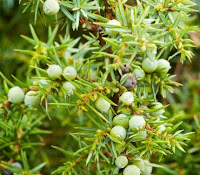
- Penny Price - Penny Price is a U.K. based aromatherapy business with distributors around the world; Penny is the daughter of Shirley and Len Price, who owned an aromatherapy business too. Penny's newsletter's are informal yet professional at the same time and this really is a family-run business.
- Aromahead Institute - I just discovered this year Andrea Butje at the Aromahead Institute; although I have yet to meet Andrea when I take her aromatherapy course next year, I have found Andrea's newsletters to be informational, yet friendly at the same time. I get the impression that Andrea is very experienced in what she does.
And of course, my own aromatherapy business, Sedona Aromatherapie, produces a monthly newsletter too! My newsletter is a work-in-progress and is continually evolving as my plans for my aromatherapy business evolve too. I am considering new ways to effectively produce a quality newsletter but currently I issue a full newsletter quarterly, and a monthly update.
If you have any suggestions or comments please let me know below!
Friday, November 20, 2009
Setting Up an Aromatherapy Business

Wednesday, November 18, 2009
Niaouli Essential Oil

Aromatherapy Publications

There are not actually that many aromatherapy publications for the aromatherapist out there, or so I have found. Some publications are more serious than others, so it depends what you are looking for. Aromatherapy publications in both the U.S. and the U.K. are limited but there are several international aromatherapy publications available. In addition, many aromatherapists who practice have their own newsletters. Here's a round up of the aromatherapy publications I have discovered so far. Please leave me a comment if you have more to add!
Aromatherapy publications:
- International Journal of Essential Oil Therapeutics (IJEOT) and the International Journal of Clinical Aromatherapy - both of these publications are for the serious aromatherapist, with experience, as they contain essential oil case studies and essential oil chemistry. The journals are edited by Bob and Rhiannon Harris, respectively, who are both British but now live in France. Visit IJCA for further information.
- Aromatherapy Today - an Australian publication but with an international slant with essential oil profiles, aromatherapy articles and research and ongoing aromatherapy events. This publication is easy to read, even if you have no experience in aromatherapy. Visit Aromatherapy Today for further information.
- Aromascents Journal - a Canadian publication which recently became available in Ezine format only. This is a similar publication in format to Aromatherapy Today. Now only available on line. Visit Aromascents Journal for further information.
- Aromatherapy Thymes - a U.S. publication which is relatively new to the market. Owner is Patricia Brooks. This publication follows a similar style to Aromatherapy Today. For further information visit Aromatherapy Thymes.
Aromatherapy is featured in many spa publications and other natural health magazines but, as a separate subject area, aromatherapy is limited in the publishing world. What new discoveries have you made recently?
My next full blog post will focus on newsletters available from aromatherapy businesses which I think are worth while.
Tuesday, November 10, 2009
Carrot Oil - Carrier Oil or Essential Oil?
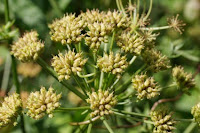 Carrot oil is both a carrier oil (or massage oil) and an essential oil. The two are very different in chemical make-up and extraction and should be used with caution. In addition, both carrot carrier oil and carrot essential oil are extracted from the wild carrot - not the domestic carrot.
Carrot oil is both a carrier oil (or massage oil) and an essential oil. The two are very different in chemical make-up and extraction and should be used with caution. In addition, both carrot carrier oil and carrot essential oil are extracted from the wild carrot - not the domestic carrot.As you can see, confusion between carrier oils and essential oils is common as well as the confusion between similar essential oils! Last week I profiled the differences between the different types of rose oil and a profile on rose hip carrier oil. Previously, I have written articles on oregano and marjoram, pelargoniums and geraniums, the chamomile essential oils, the lavender essential oils and the sage essential oils.
Knowing these similarities and differences between many carrier oils and essential oils, it is advisable to learn all you can about any carrier oil and/or essential oil before using them to avoid the confusion.
To learn more read carrot oil - massage oil and essential oil.....
and leave me any comments below!
Saturday, November 7, 2009
Do Essential Oils Work?
 Aromatherapy, like many other alternative/complimentary medicine practices often receives 'bad press' about whether it actually works. Many people believe aromatherapy to be 'just a pretty smell'.
Aromatherapy, like many other alternative/complimentary medicine practices often receives 'bad press' about whether it actually works. Many people believe aromatherapy to be 'just a pretty smell'.Some of this 'bad press' may come from the fact that aromatherapy is not regulated in the USA; anyone can set up and claim to be an aromatherapist with little or no training. In addition, some essential oil suppliers, who claim to supply 'pure' essential oils, are actually selling adulterated or unpure essential oils.
Pure essential oils are obtained from plants; plants possess essential oils for a number of reasons. Botany and aromatherapy are closely interlinked because essential oils are extracted from plants. The therapeutic powers obtained from essential oils often had an original purpose in protecting the plant too.
Scientists in many countries have conducted many experiments to try to prove or disprove the value of essential oils in certain circumstances. Sometimes the results are inconclusive, due to various factors, but many experiments end in a postive result for the power of essential oils. The International Journal of Essential Oil Therapeutics carries many indepth studies on essential oils.
Often essential oils are confused with fragrance oils; fragrance oils, although pleasant smelling, do not carry the therapeutic properties of essential oils and should not be used in the practice of healing aromatherapy.
Aromatherapy is also a phrase which is often misused. True aromatherapy is the use of essential oils for therapeutic practice but often people talk about aromatherapy when they are really talking about fragrance oils or perfumery.
Essential oils are used medicinally in France and are becoming more popular in medical practice in the U.K. too. I don't beleive that essential oils are in common practice in the U.S.A. in medical settings as yet (please let me know if you know different!) and perhaps the aromatherapy profession needs to be regulated more firmly before this can happen.
For this reason, I am planning on doing further aromatherapy training next year to greater understand the complexities in the chemical make-up of essential oils so that when people ask if essential oils really do work, I will have the knowledge and further experience to expand on my answer!
If understood correctly, and if used correctly, essential oils can be beneficial to a great many people in a number of health problems.
If you have any comments please post them below!
Friday, November 6, 2009
Rose Hip Carrier Oil
Rose hip oil is a favorite oil to be used in skin care creams and lotions but it can also be used as a massage oil, either on its own or with complimentary essential oils. To learn more more the profile Rose Hip Carrier Oil...

Wednesday, November 4, 2009
Do You Know Your Rose Oil?

Aromatherapy for Feet - New Article!
To learn more read my newest article in the Sedona Aromatherapie Library - Aromatherapy for Feet.
Let me know what you think by posting a comment below!
Friday, October 30, 2009
My Favorite Essential Oils

We probably all have a favorite essential oil; however my favorite essential oils seem to change with season and my mood!
Ultimely, I would say that my top ten list of favorite essential oils are:
For anyone who knows anything about essential oils, you can probably see that my taste is pretty expensive! However, I like different essential oils for different things; the citrus oils (of which orange is my favorite) are versatile and uplifting at any time of the year.
Some of my other favorites, such as rose, frankincense and sandalwood, are 'heavy' essential oils and I certainly wouldn't use them in excess (if not for the price alone!).
Geranium essential oil is an essential oil which I use a lot in blends for different things so for me it is a versatile and reasonably priced essential oil to have on my 'favorite' essential list.
If you have a favorite essential oil please post me a comment below and tell me why!
Wednesday, October 28, 2009
Essential Oils for the Menopause
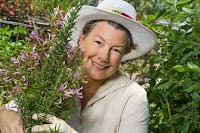
Friday, October 23, 2009
How Do I Store Essential Oils?
Before you buy an essential oil, you can't know for sure how it has been stored, or for how long, by the supplier. So, buy from a reputable and trusted supplier, or ask the questions before buying! Some essential oil suppliers will add a 'use by' date on essential oils, but again this is only a guideline and it depends on how you store the essential oil once you acquire it.
Essential oils should ideally be stored in dark colored glass bottles; these are usually colbalt blue, amber/dark brown or dark green. Essential oils should also be kept in a cool, dark place. Essential oils do not fair well in sunlight or heat and this will diminish both the shelf life and the quality and effectiveness of the essential oil.

Citrus essential oils, even when stored in ideal conditions, do not have a long shelf life; often the maximum shelf life of a citrus essential oil is one year. Grapefruit essential oil in particular can go 'off' very quickly.
On the other hand, some essential oils can be kept for years, if stored under the right conditions. These are often the base essential oils such as sandal wood, rose and patchouli.
I have been asked if it is safe to store essential oils in the fridge. I have mixed feelings about this personally. Some of the citrus oils may last slightly longer if stored in the fridge but it is crucial that the temperature in the fridge is not too low. I have made this mistake in the past and still ended up with unusuable essential oils.
Once essential oils have been mixed in an carrier oil, it is still important to store the essential oil blend correctly. I make my blends in colbalt blue glass bottles, although I do use plastic bottles for some of my creams and lotions. Just make sure the bottles meet PET standards to avoid contamination of the plastic and the essential oil blend.
When I moved from the UK to the USA, I had many of my precious essential oils shipped over with the rest of my personal possessions. However, I couldn't trust the effectiveness of them because they had endured conditions over which I had no control. They were shipped from the UK to Los Angeles by boat (6 weeks plus at sea) and then sat in a warehouse in Los Angeles before being trucked across 2 states to another warehouse of the blazing desert heat of Phoenix before I picked them up and brought them home to Sedona, Arizona! By the time they reached me they had probably suffered excessive heat and cold, amongst other things.
So, it may seem like a little thing, but the storage of your essential oils is crucial to how long your essential oils will last and the effectiveness of your essential oils!
Please post me a comment on the storage of essential oils below!
Thursday, October 22, 2009
Aromatherapy and the power of scent
To learn more read Aroma-therapy can make you appear thinner, help you get a date and make you eat certain foods
And post your comments below!

Wednesday, October 21, 2009
Essential Oils for The Later Years of Life....
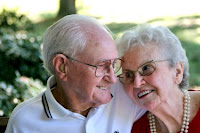 Essential oils can be used at any age - and are particularly useful in helping those in the later years of life. Problems such as arthritis, constipation and Alzheimer's disease can be helped with the use of essential oils in aromatherapy.
Essential oils can be used at any age - and are particularly useful in helping those in the later years of life. Problems such as arthritis, constipation and Alzheimer's disease can be helped with the use of essential oils in aromatherapy.Just remember to reduce quantities, take note of warnings for use in high blood pressure and other contra-indicators - and don't forget to let your doctor know, as some prescribed medications may interact with essential oils.
For more information read Essential Oils for Seniors...
Saturday, October 17, 2009
Am I Allergic to Essential Oils?
 Pure essential oils are natural and many people don't consider that they may be allergic to essential oils for that reason. Although a natural substance, an essential oil can cause allergic reactions in some people. If you think about it, people suffer from hay fever and other pollen allergies which often relate to pollen and seeds, again 'natural' elements.
Pure essential oils are natural and many people don't consider that they may be allergic to essential oils for that reason. Although a natural substance, an essential oil can cause allergic reactions in some people. If you think about it, people suffer from hay fever and other pollen allergies which often relate to pollen and seeds, again 'natural' elements.For this reason, if you haven't used a particular essential oil, and you know you are a sensitive person, it is best to do a skin patch test before using the essential oil in full. Some essential oils carry warnings that they may cause sensitization but even those which don't may cause an allergic reaction.
That being said, I am a sensitive person myself and have not experienced any allergic reactions to essential oils - but then again, everyone is different!
If you have experienced allergic reactions to an essential oil please post a comment and let me know...
Aromatherapy for Teenage Girls



Wednesday, October 14, 2009
Aromatherapy for Weddings

Although I am more interested in the clinical side of essential oils and aromatherapy and how essential oils can be used to treat various problems, I also offer aromatherapy gifts through my web stores (both Sedona Aromatherapie and Chocolate Aromatherapy). I find it useful as a way of reaching people who may not have otherwise become interested in aromatherapy.
I have had a wedding section in the Sedona Aromatherapie web store for quite a while now but haven't really promoted it. In the next month or so, I intend to look at that section again and update it. In conjunction with this, I will be building a new web site, aromatherapywedding.com, which I hope to launch in the Spring of 2010.
Recently, I did some aromatherapy wedding favors for a client, which promoted me to write the article Alternative Wedding Favor Ideas - Aromatherapy.
Aromatherapy can be used to reach many people in many ways, so why not introduce it into a wedding? Aromatherapy wedding favors and gifts are a unique way to introduce wedding guests to aromatherapy and perhaps start some onto a whole new way of looking at things.....
So, although I will continue to learn and train in the use of essential oils for specific problems, I also plan to offer unique aromatherapy gifts too in my web stores for the near future. I will keep you posted of any other unique aromatherapy gift ideas I discover!
If you have any comments on aromatherapy gift ideas for weddings or for other events please leave me a comment!
Thursday, October 8, 2009
Essential Oils for Menstrual Cramps
 Sometimes beig a woman is not easy! Especially for those that suffer from pain caused by menstrual cramps throughout their lives. Menstrual cramps can impact greatly on a woman's life for a few days every month, making it an effort for you to get through your day, never mind carry out the routine tasks expected of you at work, home and play.
Sometimes beig a woman is not easy! Especially for those that suffer from pain caused by menstrual cramps throughout their lives. Menstrual cramps can impact greatly on a woman's life for a few days every month, making it an effort for you to get through your day, never mind carry out the routine tasks expected of you at work, home and play.Essential oils can help allieviate some of the pain associated with menstrual cramps but it is important to find a combination of essential oils which suit you.
Some general suggestions for essential oils which can help with menstrual cramps include:
- peppermint
- clary sage
- geranium
- cypress
- roman chamomile
- rosemary
- pine
- basil
- aniseed
- juniper
- sweet marjoram
- fennel.
One particular blend of essential oils which I find useful for relieving menstrual cramps is:
blended together in apricot kernel carrier oil. As I've said in a previous post, the carrier oil is just as important in some instances as the essential oil. I use apricot kernel oil in a lot of blends for pain relief but there are other carrier oils too which could be used. I will be posting carrier oil profiles over the coming months, so keep reading, and like I've profiled many essential oils over the past year, I eventually hope to have a 'library' of carrier oil profiles too!
If you have any suggestions of your own for using essential oils for menstrual cramps please post me a comment and let me know!
Friday, October 2, 2009
Clary Sage Essential Oil
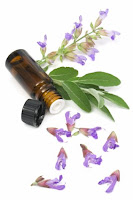 Clary sage essential oil is a very good oil for the ladies! It helps with a lot of problems women suffer from PMS to menopausal problems. However, clary sage essential oil shouldn't be confused with common sage essential oil which is more toxic in its actions.
Clary sage essential oil is a very good oil for the ladies! It helps with a lot of problems women suffer from PMS to menopausal problems. However, clary sage essential oil shouldn't be confused with common sage essential oil which is more toxic in its actions.To learn more read my latest article, Clary Sage Essential Oil.
If you have any suggestions or comments on the use of Clary Sage essential oil please post me a comment!
Wednesday, September 30, 2009
Essential Oils for Women's Health

Monday, September 28, 2009
Properties of Carrier Oils

When deciding to study aromatherapy and essential oils, many people focus on learning all they can about essential oils and what they can be used for. However, although the properties of essential oils are important, it is also important to consider the properities of the carrier in which you are going to put the essential oils.
Carriers for essential oils can include:
- white lotion
- bubble bath
- shampoo
- distilled water
- milk
- honey
- oil.
Perhaps the most important of these is the carrier oil. There are many carrier oils which can be used in aromatherapy for essential oils and many carrier oils carry therapeutic properties of their own, in addition to the properties of essential oils. For example, I make up the following blend for back and neck pain:
- frankincense (Boswelli carteri) essential oil
- lavender (Lavendula angustifolia) essential oil
- roman chamomile (Chamaemelum nobile) essential oil
- apricot kernel (Prunus armeniaca) carrier oil
Apricot kernel carrier oil, in itself, has the ability to be pain-relieving, in addition to the pain-relieving properties in the essential oils used. This is just an example of how carrier oils can enhance the overall synergestic blend of essential oils.
Many carrier oils possess therapeutic properties and many are good for certain types of skins too, making them excellent for use in skin care blends.
Over the coming weeks, I intend to profile a few carrier oils in my article writing and will provide links on Aromatherapy Notes when I do. If there is a particular carrier oil you would like to know more about or see profiled, please let me know either by e-mail or by posting a comment at the end of this post!
For further reading : Using Carrier Oils in Aromatherapy Blends
The Properties of Essential Oils
The Jojoba Plant - one of the more popular carrier oils in the USA
Saturday, September 19, 2009
An essential oil garden....
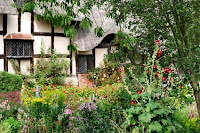 Did you know that you could have a myriad of essential oil potentials in your very own garden or yard? Many essential oils come from common plants and flowers in our own gardens, depending on which part of the world we live in.
Did you know that you could have a myriad of essential oil potentials in your very own garden or yard? Many essential oils come from common plants and flowers in our own gardens, depending on which part of the world we live in.Some examples of plants and flowers which you could grow in your back garden and distil in a home made still (something I have yet to try!) include:
- lavender (lavandula angustifolia)
- rose (rosa damascena)
- rosemary (rosmarinus officinalis)
- peppermint (mentha piperita)
- thyme (thymus vulgaris)
- chamomile (chamaemelum nobile)
If you live in a warm climate, it may be possible to grow some of the citrus fruit trees, such as mandarin and lemon, although essential oils extracted from citrus fruit trees are cold expressed and not usually steam distilled.
Aside from the possibility of essential oils, the natural fragrance alone of these many plants and flowers, can be uplifting on a summer's day; as the season changes to fall, it is something to think about for next year...
To read the full article I wrote on essential oils in the garden, read An aromatherapy garden , originally published at Sedona Aromatherapie...
If you are a gardener, you may also be interested in How to use essential oils in the garden, the natural partner for the garden.
If you have any comments on essential oils and gardens let me know by posting a comment below!
Thursday, September 17, 2009
Essential Oils for Pregnancy
 Are essential oils 'safe' for use in pregnancy? And if so, which essential oils can you use? These are questions which are hotly debated by therapists and others around the world.
Are essential oils 'safe' for use in pregnancy? And if so, which essential oils can you use? These are questions which are hotly debated by therapists and others around the world.Often essential oils are not used in pregnancy and are not advised for use in pregnancy due to fear; however, although some essential oils are safe for use in pregnancy, some are most definately not suitable for use in pregnancy. It also comes down to using an essential oil correctly and safely.
Read more on how to use essential oils for pregnancy...
Monday, September 14, 2009
Essential Oils For Allergies

Saturday, September 12, 2009
Aromatherapy Foot Blends
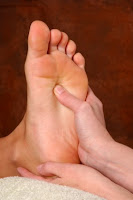
- Lavender (Lavandula angustifolia)
- Peppermint (Mentha piperita)
- Geranium ((Pelargonium graveolens)
- Rosemary (Rosmarinus officinalis)
- Fennel (Foeniculum vulgare)
- Lemon (Citrus limon)
- Roman Chamomile (Chamaemelum nobile).
Essential oils can be blended in carrier oils and creams. Aromatherapy foot blends can be used daily after bathing and showering to relieve tired and sore feet. Its also possible to make uplifting sprays to revive tired feet and treat feet with an aromatherapy foot scrub to get rid of dead skin cells.
When using any essential oil, don't forget to pay attention to any cautions or contra-indicators for your personal condition.
In celebration of world reflexology week, I've just launched an Aromatherapy for Feet Section in the Sedona Aromatherapie web store!
To learn more about reflexology read The Egyptian Influence on Reflexology.
Read World Reflexology Week for more information on world reflexology week.
If you have any questions or comments about reflexology and using aromatherapy please leave me a comment or contact me!
Monday, September 7, 2009
What is an Organic or Wild Crafted Essential Oil?

Its not something I originally gave much thought too as I was taught essential oils should be pure. So a 'pure' essential oil is 'organic' isn't it?
Well, not exactly. Although 'pure' essential oils are 'pure' in the fact that they are 100% obtained from plant material and not synthetically made, it depends on how the original plant is grown and farmed to earn a label of 'pure', 'organic' or 'wild crafted'. 'Pure' essential oils may have actually been treated with pesticides in the farming process and although it is argued that only a miniscule amount (if any) is transferred through the distilling process of an 'pure 'essential oil, it is not an 'organic' or 'wild crafted' essential oil.
An 'organic' essential oil has to meet strict guidelines which ensure the plant material has been grown and farmed organically; this has to meet the growing country's criteria for organic farming. A farmer has to be certified as an organic farmer to be able to produce plants which will distill organic essential oils. Consequently, 'organic' essential oils are usually more expensive than 'pure' essential oils as they are more costly to produce, distill and market.
'Wild crafted' essential oils are obtained from sources of wild crafted plants; this may happen naturally, or can be cultivated, if the plants and farming methods again meet certain critieria.
There may be times when there is overlap between 'pure', 'organic' or 'wild crafted' essential oils; for example, some plants don't need pesticides or fertilizers to produce essential oils and are, by their very nature, naturally 'organic' or 'wild crafted'.
As the essential oil business is often a large, commercialized machine it is, again, important to know who your essential oil supplier is and where they obtain their essential oils from; knowing how their essential oils are distilled, farmed and by what methods in which countries, will make you more knowledgeable about whether your essential oil is 'pure', organic' or 'wildcrafted'.
It has made me re-think too more about what the essential oil actually is that I am buying, in my search for reputable and quality essential oil suppliers in the USA! I think that it is also making me a knowledgeable aromatherapist in the process!
If you have any thoughts or additional comments on pure, organic or wild crafted essential oils please post comment at the end of this post!
Thursday, September 3, 2009
Essential Oils for Skincare
 As discussed in my previous post, Historical Use of Aromatherapy in Skincare, many ancient civilizations, including the ancient Egyptians used plants for cosmetic and skin care needs. It was perhaps not in the form of essential oils as we know them today, but many of the plants and flowers which we use in skin care today were , in fact, used; examples include rose, lavender and myrtle.
As discussed in my previous post, Historical Use of Aromatherapy in Skincare, many ancient civilizations, including the ancient Egyptians used plants for cosmetic and skin care needs. It was perhaps not in the form of essential oils as we know them today, but many of the plants and flowers which we use in skin care today were , in fact, used; examples include rose, lavender and myrtle.Essential oils access the body in a number of ways, including absorption through the skin. That is why it is important to know the chemical components of an essential oil and know what to use it for, as your body will absorb the essential oils applied to it. However, as essential oils are usually recommended for dilution in a carrier oil first, the amount is usually minute, but still effective, meaning knowledge of the particular essential oil you are using is important.
Your skin will react in different ways to an essential oil depending on a number of factors. These include:
- your age
- stress
- exercise
- diet
- lifestyle
- the environment
- health.
Depending on your skin type, here's a few recommendations of essential oils for different types of skin:
- dry skin - dry skin needs moisture; dry skin may be sensitive too so gentle essential oils are recommended such as rose, lavender, roman chamomile, sandalwood and patchouli. Good carrier oils for dry skin include avocado, hazelnut and evening primrose.
- mature skin - to stimulate cell growth and to treat wrinkles, mature skin benefits from the essential oils of frankincense, palmarosa, clary sage, lavender and neroli; borage, wheatgerm and vitamin E bases are good carriers for mature skin.
- oily skin - oily skin results in congestion and spots; the PH balance of oily skin can be re-balanced by using the essential oils of geranium, tea tree, cedarwood and lemon or any other essential oil which has astringent or antiseptic properties. Jojoba and apricot kernel are good carrier oils to use as they are light and easily absorbed.
These are just a few of my suggestions for essential oils for skincare; there are many books on the subject, all with a number of aromatherapy recipes for you to try. The only way to know for sure if a blend is going to work for you is to experiment and try a few different essential oil blends before finding an aromatherapy blend for skincare which truly works for you!
Tuesday, September 1, 2009
Yarrow Essential Oil
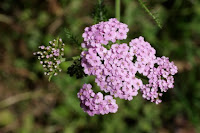 Yarrow is an essential oil which is chemically composed in a similar way to a couple of the chamomile oils. It is said to have gained its latin name, Achillea, from the Greek warrior Achilles.
Yarrow is an essential oil which is chemically composed in a similar way to a couple of the chamomile oils. It is said to have gained its latin name, Achillea, from the Greek warrior Achilles.It has a number of uses and properties in aromatherapy; read Yarrow Essential Oil to learn more....
Wednesday, August 26, 2009
The Historical Use of Aromatherapy in Skincare
.jpg)
Now, I can't be in the vicinity of a synthetic perfume without having an adverse reaction to it! And I have slowly changed my skin care routine to include only products I have made with pure essential oils.
Although essential oils, as we know them today, weren't around hundreds of years ago, a form of 'aromatherapy' was; people used natural plants and oils from plants for cosmetic purposes.
Since historic times, many ancient civilizations have used natural plants and oils in their skin care routines. The Romans were famous for adding lavender to the Roman baths; the Romans also thought highly of rose too. On a trip to the ancient city of Pompeii in Italy last summer, I was fascinated to discover that excavations of Pompeii have unearthed proof that many Pompeiians both grew and used many flowers and herbs for culinary and cosmetic purposes; these plants are ones which we are familiar with today and include rose, lily, laurel, fennel, myrtle and myrrh.
Another important figure from history - this time French history - is Marie Antoinette of France (1755 - 1793) who used many natural perfumes and oils in her skin care routine; Marie Antoinette had her own personal perfumer to make her natural scents and lotions on a whim. In fact, it is said that Marie Antoinette's obsession with her perfumes and lotions may have cost her her life; the delay in preparations for fleeing France was due to Marie Antoinette's toilette preparations, which made those no longer loyal to the Queen suspicious of her intentions. Marie Antoinette was eventually captured and sent to the guillotine.
For more information, read my articles The Perfumes of Marie Antoinette and The Ancient Perfumes of Pompeii.
If you are really interested in Marie Antoinette of France and, in particular her use of perfumes, I highly recommend reading A Scented Palace by Elisabeth de Feydeau 2007 I.B. Tauris and Co. Ltd (UK and USA).
For more on the ancient perfumes of Pompeii I highly recommend Perfumes, Unguents and Hairstyles in Pompeii (Profumi, ungenti e acconciature in pompei antica) by Carlo Giordano, Angelandrea Casale 2nd edition Bardi Editore Roma, Italia.
If you have any thoughts or comments on the historical use of aromatherapy in skin care please post a comment!
Next time, I'll discuss essential oils suitable for skincare...
Saturday, August 22, 2009
Essential Oils Not Recommended for Aromatherapy Use
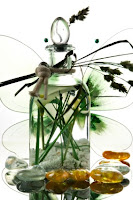
Thursday, August 20, 2009
The Importance of Latin Names in Identifying an Essential Oil
 Cranesbill is not where geranium essential oil comes from
Cranesbill is not where geranium essential oil comes from There are many species of lavender
There are many species of lavenderFriday, August 14, 2009
Myrtle Essential Oil

Myrtle was used by the ancient Greek Dioscorides and has a lot of associations with love! Most notably it was associated with Aphrodite, the Greek goddess of love, and legend tells that Aphrodite hid her nakedness behind a myrtle bush! Greek brides today often carry myrtle in their bridal bouquets and even Queen Victoria of England mixed myrtle in her 1840 bridal bouquet, together with snowdrops. However, for its therapeutic properties, myrtle essential oil is most used for its antiseptic power - to learn more read my latest essential oil profile - myrtle essential oil...
How to Create an Aromatherapy Spa

Wednesday, August 12, 2009
Do You Have Suggestions for Aromatherapy Notes?
I would love to hear anyone's suggestions or comments on any of aromatherapy notes blog posts or what you would like to see more (or less!) of! In addition to writing aromatherapy notes, I also maintain the Sedona Aromatherapie website library, Sedona Aromatherapie's facebook fan page and am in the process of (in the next year) adding more sister aromatherapy websites (products and articles) to the Sedona Aromatherapie family! I regularly contribute to the aromatherapy section at suite101, an online media magazine and I also tweet about Sedona Aromatherapie and other aromatherapy articles on twitter too!
Look forward to your thoughts and comments!
How to Use Essential Oils at Home

Thursday, August 6, 2009
The Extraction of Essential Oils by Hydro-Diffusion (Percolation) and Carbon Dioxide Extraction

As discussed in the post The Extraction of Essential Oils by Distillation and Expression, there are now new methods of extracting some essential oils. Both hydro-diffusion and carbon dioxide extraction are new methods, and there are some essential essential oils for sale which will be described as, for example, 'CO 2 extracted'. Although distillation of essential oils remains the most popular and most frequently used method of extracting essential oils, it is worth mentioning the two newer methods of hydro-diffusion and carbon dioxide.
- Hydro-Diffusion Extraction (also known as percolation) - is the newer of these two extraction methods for essential oils. It is quicker than distilling an essential oil and works much like the process of a coffee percolator (hence its alternative name of percolation). As it is a fairly new procedure for extracting essential oils, it is not known yet whether essential oils obtained through hydro-diffusion extraction is of the same quality as those obtained through distillation. Additionally, not all essential oils, are suitable for hydro-diffusion.
- Carbon Dioxide Extraction - as the name suggests, carbon dioxide extraction uses carbon dioxide to extract essential oils. It is an expensive method of extracting essential oils, using both high pressure and low temperature to extract the essential oil from the plant material. It is said that carbon dioxide extraction produces an essential oil which is closer to the essential oil present in the plant (remember that the 'essential oil' obtained through distillation is not the same as the essential oil present in the plant; chemical components are 'altered' through the extraction process). Carbon dioxide extraction does not leave a trace of carbon dioxide in the resulting essential oil and essential oil suppliers are marketing these essential oils as 'pure'; however, the essential oils obtained through carbon dioxide extraction are usually more expensive.
Personally, I have traditionally used distilled or expressed essential oils for pure aromatherapy use - until now. If research continues into the newer methods of hydro-diffusion and carbon dioxide extraction and I am convinced these essential oils are also pure, and can be bought at a reasonable price, I may consider using them in the future...
Saturday, August 1, 2009
The Extraction of Essential Oils by Distillation and Expression

For anyone who studies essential oils, distillation is probably the most familiar method of extracting essential oils from plant material; however, not all essential oils can be steam distilled. Most citrus oils, for example, are expressed. So what does 'distilled' and 'expressed' mean? And why are there different methods of extracting essential oils?
Essential oils can be extracted in the following ways:
- Distillation - the most common method of extracting essential oils and a method which has been used for centuries essentially. Plant matter which is steam distilled is in placed in a still, heated and the essential oils (the 'aroma' molecules of the plant) evaporate into the steam. The molecules are then carried along a pipe and when they start to cool (as the pipe passes through a cold water vat) the molecules form into liquid - the essential oils. The essential oils can be separated from the water, as the essential molecules either "sink or float' on the water.
Distillation is used to extract essential oils from the sacs stored in the leaves, roots, seeds and flowers of plants. Aromatherapy and Botany explains more of the storage of essential oils by plants. Some plants have no difficulty producing a large quantity of essential oil in one batch, others are extremely difficult to extract from with minute quantities of essential oil produced in a single batch.
- Expression - citrus fruits are usually expressed to extract essential oils. Essential oils are located in the rind of the fruit and need to be 'squeezed' out - a bit like when you peel the orange and the juice is 'squeezed' out of the fruit, except it is the rind which is expressed in the case of the majority of the citrus essential oils. The problem with expressing pure essential oils from citrus oils is that, in today's world, many fruit trees are chemically sprayed, 'contaminating' the rind of many citrus fruits. For this reason, many aromatherapists prefer to use organic or naturally grown fruits for essential oils (although these terms can be 'open to interpretation' sometimes too!)
Newer methods of extracting essential oils include Carbon Dioxide Extraction (CO 2 essential oils) and Perculation which is coming up next...
Do you have any comments to add on my post on the extraction of essential oils? Add you comments below if you do!
Friday, July 31, 2009
When is an Essential Oil not an Essential Oil?

Monday, July 27, 2009
Medieval 'Aromatherapy' Herbals





